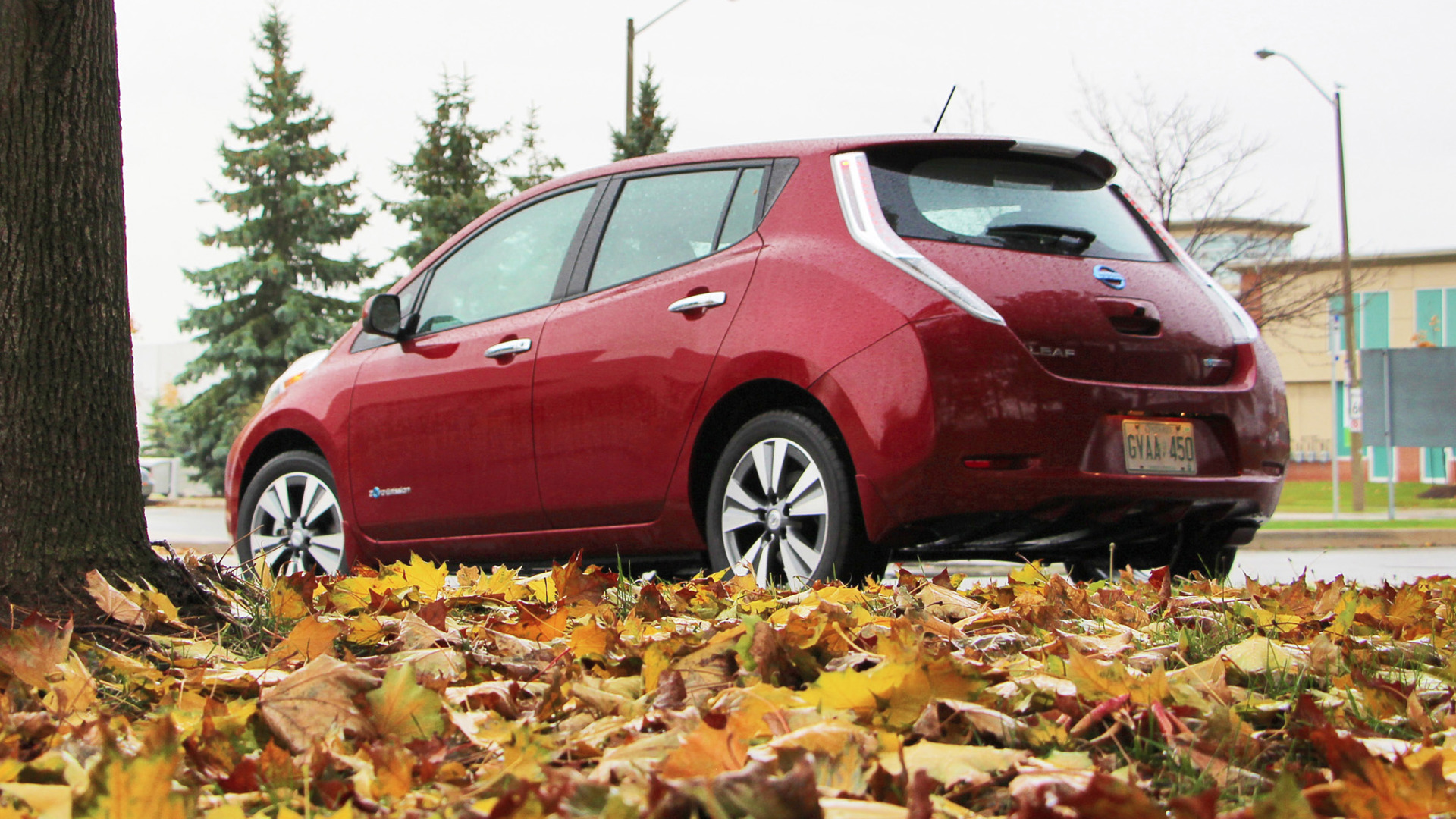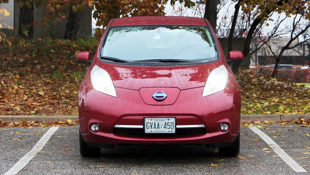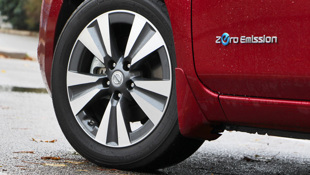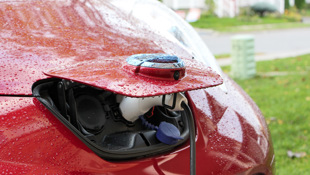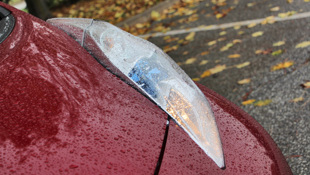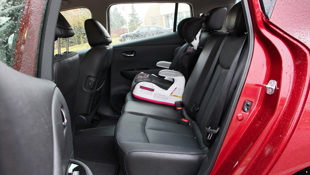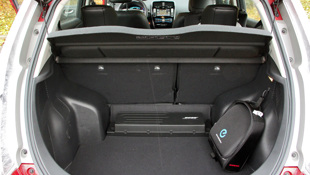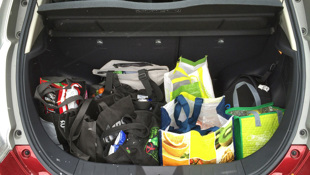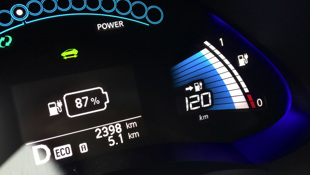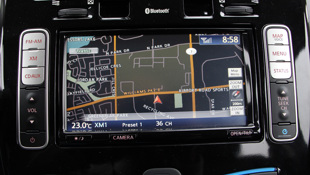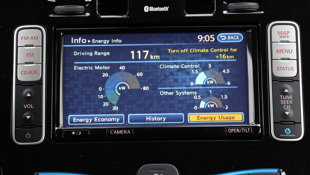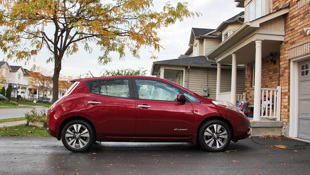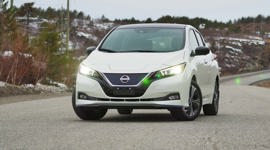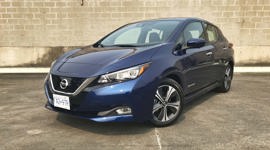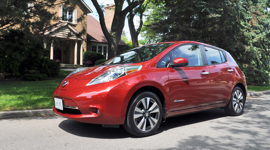 AutoTrader SCORE
AutoTrader SCORE
-
EXTERIOR STYLING1/10
-
INTERIOR4/10
-
PERFORMANCE9/10
-
COMFORT8/10
-
FUEL ECONOMY10/10
Wikipedia defines a “backronym” as “a specially constructed acronym created to fit an existing word. For example, NASA named its space station treadmill the Combined Operational Load-Bearing External Resistance Treadmill (COLBERT) after Stephen Colbert. The backronym was a lighthearted compromise in recognition of the comedian's ability to sway NASA's online vote for the naming of an ISS module.”
Perhaps Nissan should take a page out of NASA’s book…
Instead of “Leading, Environmentally friendly, Affordable, Family” car (the LEfAF, apparently), I think Green Operational Regenerative Energymobile (the GORE) or the Clean Low Orbit Original New Energy mobilitY, erm, solution (the CLOONEYs) could work, because name recognition sells. Never mind the fact that Leaf is a great name for an environmentally friendly electric car (because nature!), the notion that Nissan wants to earn an all caps LEAF at every mention seems a bit greedy for a company making a concerted effort to lower its footprint and make the world a better place.
To this day, Nissan is the only company ever to send me out to do manual labour on a volunteer project for an automotive event, and I love them for it. However, only one other automotive writer showed. Perhaps it had something to do with the Nissan Titan they were demonstrating, umpteen years into its product cycle. That is not their only charity endeavour, as Nissan Canada (and globally) is also actively engaged in Habitat for Humanity and other charitable causes.
Why am I discussing charitable causes in a Nissan Leaf review? Well, as much as I hate to say it, the LEfAF Leaf is a bit of a charity case, but it is also reflective of Nissan’s efforts to make the world a better place. I’m sure corporate profits and tax exemptions for charity have nothing to do with it. Anyhow, the Leaf was the first affordable mainstream mass-market electric vehicle in North America, and competes mainly with California-specials built only to satisfy California legislation requiring manufacturers to sell X number of fully electric vehicles (EVs) in order to continue selling cars in California. It remains the only widely available electric vehicle riding on a dedicated EV platform accessible to average buyers. The Tesla is still just far too expensive for most families.
Like the original Prius, Nissan is surely taking a bath on every Leaf they sell, now priced as low as $31,798 for the base S model (ironic?), with such notable features as 16-inch steelies, spoiler and underbody aerodynamic panels, intelligent key, Bluetooth, cruise control, back-up camera, heated front and rear seats, heated leather steering wheel, AM/FM/CD four-speaker stereo with USB connection. That is not half bad for equipment level compared to some hatchbacks that end up at a similar price point, and very competitive in Ontario and Quebec where you can still collect up to $8,500 in rebates through government subsidies. At that reduced price, you’re comparing it with the Kia Forte5 EX AT, VW Golf 1.8T Comfortline Auto or TDI Trendline, or Mazda3 GS Auto.
Residents of the rebate provinces can compare this fully loaded Leaf SL to the same trims in the vehicles assembled for our hatchback comparison test. Starting at $38,548, a lone metallic paint option and the requisite freight and A/C tax take the total to $40,673, minus $8,500 from the Ontario government and it is essentially on par with the $33,585 Golf 1.8 TSI Highline that won our little comparison. In the Leaf SL, the full feature list includes such amenities as navigation on larger 7-inch screen (base screen is 4.3 inches), super-duper 360-degree Around View Monitor (no more parking fails!), premium seven-speaker Bose audio (not the greatest sound quality despite the branding), satellite radio, Homelink universal garage door opener, cargo cover, leather seats (the mid-trim SV offers partially recycled cloth seats), automatic LED headlights (which, like the stereo, failed to impress), fog lights and 17-inch alloy wheels. There is also a tiny solar panel that collects energy to power vehicle accessories – a shame it’s so tiny, when there’s an entire roof available and no sunroof option is offered. That’s a lot of technology and stuff.
The seats are comfortable, the back seat spacious enough for child duty, the plastics and materials are competitive with the Micra, and the shifter knob-thingy is just plain annoying, but it’s still a reasonably practical car. Sort of.
Aside from the cost of entry, which we’ve now established isn’t really that far off similarly sized vehicles, there is another price to pay for the electric powertrain, and it comes at the expense of practicality. The trunk measures no better than 411 L, and the folding the 60/40 split seats leaves a large raised area as the seatback simply sit on top of the seats, which are level with the cargo floor. All told, the Leaf cargo volume only yields a maximum of 849 L. It’s better than the Volt with 300 L in the trunk, but the Prius manages 612 in the trunk alone (no figures given with seats folded), and the Kia Soul EV manages 532/1401, and something like the Golf offers 645/1492. Still, it’s a fair bit better than any hybrid sedan, some without folding seats and others with vestigial pass-throughs that are essentially useless.
Those sedans do look better than the unfortunately styled Leaf, about which the only positive I can muster is that it looks better than the Juke… But hey, it’s a very aerodynamically efficient shape, at least, right? Well, yeah, compared to a Suburban, but in Car and Driver’s unique wind tunnel “Drag Queens” comparison, the Leaf was rated worst drag area at 7.8 ft2, this out of five cars that included the Tesla Model S, Toyota Prius, Chevrolet Volt, Mercedes-Benz CLA 250.
Oh yeah, did we mention it’s an electric car? Its 80 kW AC synchronous electric motor generates the equivalent of 107 hp and 187 lb-ft of torque to motivate the 1,518-kg Leaf SL. It feels absolutely class competitive as a comfortable little cruiser, in no way encroaching on sporty gas-powered hatches, but feeling confident and far superior to the sluggish Prius, on par with something like the C-Max, but perhaps short of the Chevy Volt’s combined 150 hp and 273 lb-ft. The single speed reduction gear transmission means acceleration is seamless and smooth, the lack of combustion means the drivetrain is nearly silent aside from a hint of whine, and road noise is commendably subdued for a quiet, pleasant ride. In Eco mode (which I stayed in all week), coming off the throttle begins to engage the regenerative braking, so once you get used to it you can do a lot of driving using just the throttle and using very little brake pedal.
The suspension is likewise tuned for comfort and the tires selected for efficiency and comfort as well, so the Leaf soaks up road disturbances admirably up to a certain point. Some harsh impacts will resonate with clunking and unpleasant clatter from under the cabin. Let’s just not talk about the steering. Okay, maybe just a little. Steering is light and easy. You can even pick up the pace even in the corners, and the stability is commendable because of the low-centred weight of the batteries under floor, but the tires and steering just want nothing to do with lateral g-forces. Take that for what you will.
Speaking of batteries, the Leaf is packing a 24-kWh lithium-ion battery that promises up to 160 km of range in fantasy land, but likely a realistic 130-140, and significantly less in winter. I had no issues on my 50-km round trip, with occasional lunch runs and detours racking up as much as 70-80 km in a day, but I didn’t even fully charge overnight, using simply our 110V household outlet in the garage overnight every night, and getting a full charge at a nearby free charging station. On some days I saw range drop by about 60 km while covering 50 km as recorded by the trip computer, while other times I saw range plummet over short distances (18 km of range over 5 km travelled one time), especially when matching the flow of traffic on the highway when moving at normal speeds (110–130 km/h around these parts). Transport Canada rates it at 1.9 Le/100 km in the city and 2.3 Le/100 km on the highway, for whatever that’s worth. Perhaps more clear is their estimated fuel cost per year: $442.
Of greater concern were the tracking tools. Between the gauges and the infotainment system, the Leaf has the space to display a wide variety of information, but fails to as much information as I would want in an electric vehicle. Nowhere could I find a total energy consumption in kWh, and the main consumption figure was in the annoyingly backwards km/kWh – rather than kWh/100 km that would allow equivalency to the government’s Le/100 km and other electric and plug-in vehicles’ superior tracking tools (C-Max, Tesla, Prius Plug-in and more). It’s a byproduct of the dominant American market and the equivalency to US MPG measures.
Perhaps it is all available in CarWings, Nissan’s smartphone app that allows remote access to the charging and climate functions, while providing real-time charging and range status, which, by law, you cannot access on your smartphone while driving. Carwings also provides locations of available charging stations in the nav system, but it’s nowhere near as comprehensive as Plug’n Drive and CAA’s charging station locator (note to self: bookmark this on smartphone next time driving EV).
Anyhow, in almost 400 km of driving at 5.8 km/kWh, I used a total of almost 70 kWh, and at a household rate of 7.7¢/kWh (overnight off-peak rates in my area), plus ridiculous fees pretty much doubling that rate, I spent a maximum of $10 in a typical week of driving that would normally run somewhere between $40 to $60 (depending on the car of the week). Our own Michael Bettencourt, Leaf owner and electric vehicle aficionado estimates his consumption at roughly $20-$40 per month, measured much more accurately by separate meter on their stage 2 home charging station. It’s fun to save money.
In its first couple years, the Leaf was hampered by slow production limited by battery supply, but the construction of a dedicated lithium-ion battery plant in Smyrna, Tennessee allowed them shift production to the States, reduce the production costs and consequently MSRP, and sell up to market demand, upwards of 23,000 in North America last year, already surpassing 25K this year, and only next year likely to be indicative of full production capacity and consumer demand. The Chevrolet Volt, despite being awesome, has never cracked the 25K mark in North America. The battery plant is designed to produce up to 200,000 batteries for use in other Nissan electric vehicles. Bring on Sparky.
So, to sum up, the Leaf is a good car, a practical hatchback for small families, brilliantly efficient for city folk and commuters, limited mostly to second-car status because of range, and reasonably priced in two provinces that still offer EV rebates, and now more widely available. However, the Kia Soul EV is a new entrant in this segment and does a lot of things better for a similar price.
*up to $8500 in provincial rebates in Ontario and Quebec
| Model Tested | 2015 Nissan LEAF SL |
|---|---|
| Base Price | $38,548 |
| A/C Tax | $100 |
| Destination Fee | $1,990 |
| Price as Tested | $40,673* |
|
Optional Equipment
Metallic paint – $135
|
|
